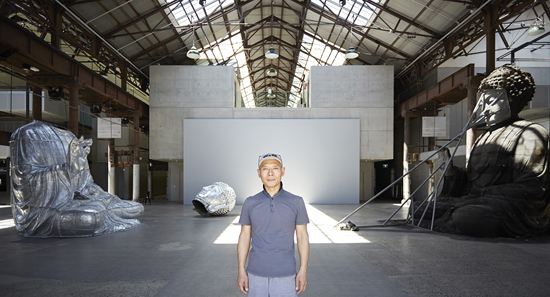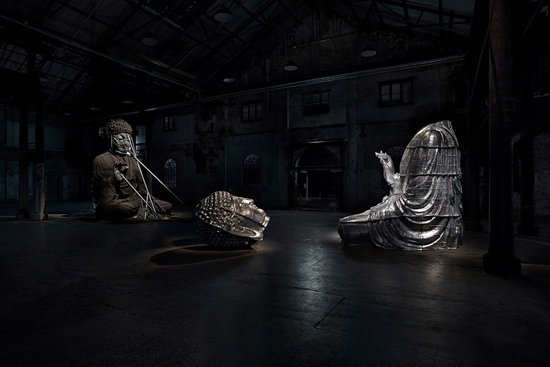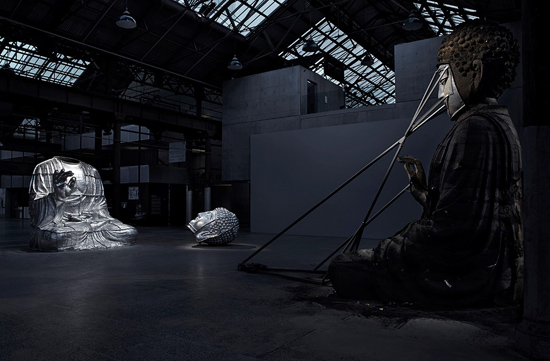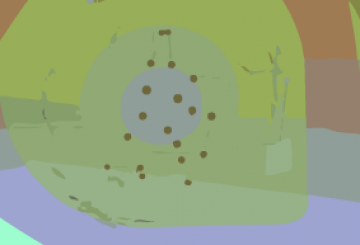From Luise Guest…
Portrait of Zhang Huan with Sydney Buddha, 2015. Image: Zan Wimberley.
Two weeks ago, in Beijing, new media artist Zhang Xiaotao told me that he is hoping for a “Buddhist Renaissance” in China, as an antidote to the sickness of materialism and the headlong rush to acquire wealth that has overwhelmed traditional values. In the same week, in separate conversations, three other contemporary artists – a painter, a photographer, and a performance artist – spoke of their immersion in Buddhist practice and philosophy. It seems there is something in the zeitgeist (in Chinese “shidai jingshen” – the spirit of the times.) Today Zhang Huan’s installation for the Sydney Festival was unveiled. ‘Sydney Buddha’ looms out of the shadows of the vast industrial spaces of Carriageworks with an undeniable presence. Like its previous iterations in Taiwan and Florence, the work consists of two giant Buddha figures, each over 5 metres tall, facing each other. The first is constructed of aluminium, the second of ash. The ash Buddha will gradually disintegrate over the course of the exhibition, evoking permanence and transience, life and death, past and present. The work is still, solemn, and very beautiful.
Zhang Huan, Sydney Buddha, 2015, ash and aluminium. Presented by Carriageworks in association with Sydney Festival, courtesy PACE Gallery, New York. Image: Zan Wimberley.
The hollow aluminium Buddha figure acts as a mould to form the second Buddha, created from 20 tonnes of ash collected from temples in Shanghai, Jiangsu Province and Zhejiang Province over three years. Two of Zhang Huan’s studio assistants supervised the construction and installation of the piece at Carriageworks. The ash, mixed only with water, was pushed into the mould, compressed as tightly as possible, a painstaking and physically challenging process which took days. At the opening of the exhibition the final supports and the mould covering Buddha’s face will be removed by the artist. He suspects that the face will immediately fall away, releasing all the prayers and wishes embodied in the ash into the air. Often connected with the veneration of ancestors and with funerary ritual, the incense and paper burned in the temples which creates the ash is sacred. Zhang Huan says it embodies “the collective memories and hopes of all Chinese people.”
In 1994, as a radical young performance artist in Beijing’s Bohemian East Village artists’ community, Zhang Huan covered himself in fish oil and honey to attract flies, and sat naked in the foul stench of the communal latrine in a feat of endurance called ‘Twelve Square Metres’. In the same year, Zhang suspended himself in metal chains from the ceiling of an East Village hut, while his blood from a cut on his body dripped into a heated metal bowl. These provocative works arose out of the experiences of his generation, who had emerged from the madness of the Cultural Revolution into a very different China. It seems hard to reconcile the author of those transgressive early works with the gentle and softly spoken artist who arrived from Shanghai this morning and went straight to Carriageworks to check on the installation of his monumental installation. I asked Zhang Huan to comment on the dramatic change in his practice. “This change is natural – and also destiny,” he replied through a translator. “Like the philosopher says, you cannot stand in the same river twice. When I was young I was afraid of many things. But now I fear [even] more – I can see my destiny. There is a Confucian doctrine which states that at the age of 50 you know your destiny. I am 50 now!” He is thinking about mortality, memory and the revival of important spiritual traditions in China.
Upon his return to China in 2006, after living in New York for some years, he began to work in more traditional forms of sculpture, and ash has become his primary medium. When he moved to Shanghai he went to the Longhua Temple to burn incense, noticing that the temple floor was covered with ash which had leaked from the giant incense burner. He wrote, “Seeing this image of ash conjured a feeling inside of me: it was a beautiful material and it moved me greatly. These ash remains speak to the fulfilment of millions of hopes, dreams and blessings. It was here that I finally discovered the ingredient I had been looking for to pave the way for new work.”
Zhang Huan, Sydney Buddha, 2015, ash and aluminium. Presented by Carriageworks in association with Sydney Festival, courtesy PACE Gallery, New York. Image: Zan Wimberley.
The ephemeral nature of the work implies many things: the collective memory, the soul, and also “the collective ineffectiveness arising from taking action when none should be taken, upsetting the natural order of things,” says the artist. “To some, ash seems useless and insubstantial; it is a short-lived witness to human spirituality and spiritual practice. To me, it carries unseen sedimentary residue, and tremendous human data about the collective and individual subconscious.” Zhang Huan contemplated two technicians in a forklift loosening the screws holding the final supports of the ash Buddha in place, in preparation for the dramatic moment of their removal. He said, “I hope that the Buddha can bring more blessings and happiness to this city which is so beautiful and so free.”
Zhang Huan: Sydney Buddha is presented in the main public space of Carriageworks from 8 January to 15 March 2015. Entry is free. The artist’s website: http://www.zhanghuan.com/




